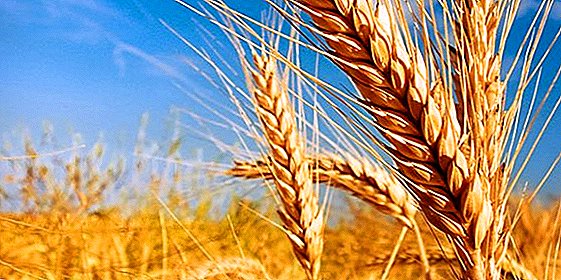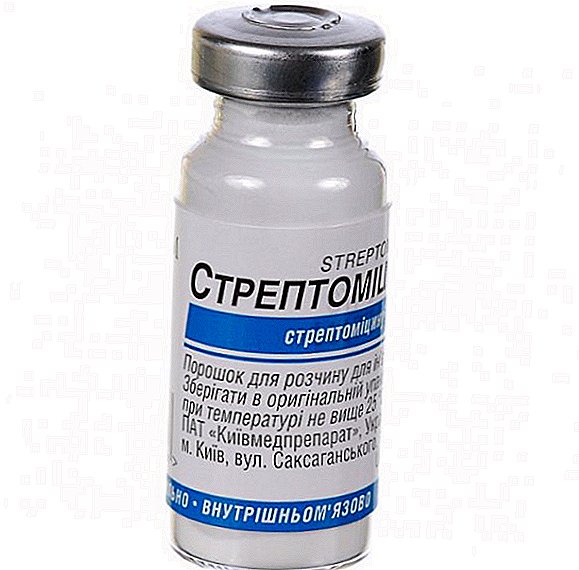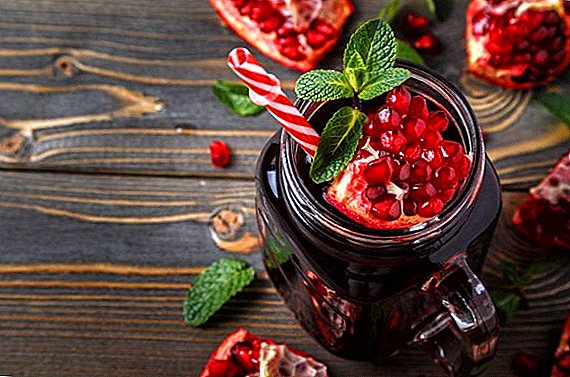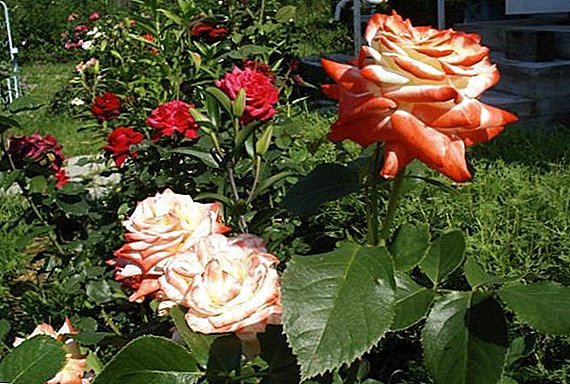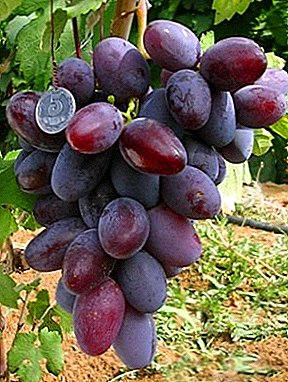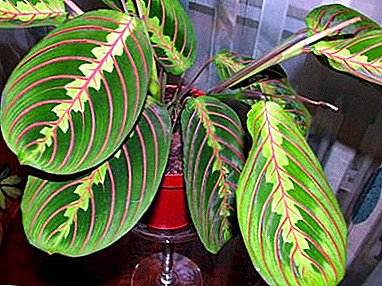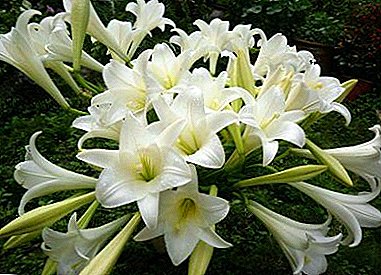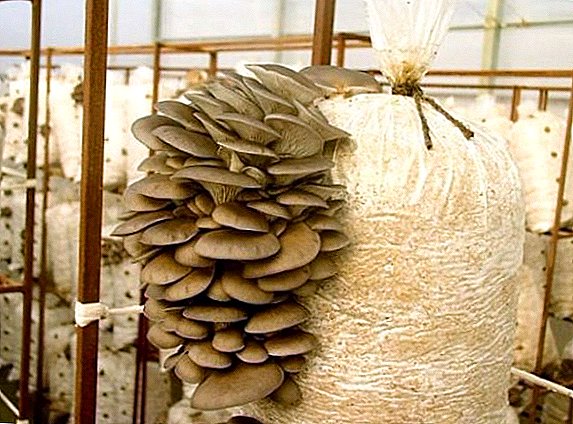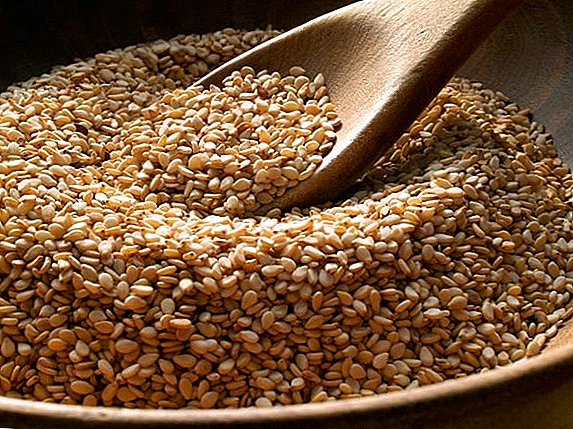 This plant was known to ancient people and enjoyed no less popular than it is now. Many legends are devoted to him and many magical properties are attributed. Learn all about sesame: its beneficial properties, the rules of cultivation and how to use it in traditional medicine.
This plant was known to ancient people and enjoyed no less popular than it is now. Many legends are devoted to him and many magical properties are attributed. Learn all about sesame: its beneficial properties, the rules of cultivation and how to use it in traditional medicine.
Description
Sesame ordinary (Indian, sesame or Simsim) - an annual herb, belongs to the sesame family. Its height reaches 1.5-3 m.
Did you know? The Japanese, known long-livers, use sesame more than all other inhabitants of the Earth. The duration of their life depends on this plant, which cleans and strengthens blood vessels.

It has impressive roots that penetrate the ground 1 m deep. The branches are four or octahedral. Lower leaves are opposite, further the sequence of growth is observed. Large white, cream, yellowish-bluish flowers grow in the "axils" of the leaves. The flowering period refers to June-July, the fruits appear in autumn - in September-October. Numerous (up to 80-100 pieces) ovoid seeds of black and white colors are in a multi-faceted box with a conical top and a rounded bottom. Its length is about 3 cm.
This plant has received the greatest distribution in Africa, India, China, the Far East, and Central Asia. Myanmar (Burma) ranks first in cultivation, followed by India and China. The popularity and demand for sesame is related to its seeds and the oil that is produced from it. 
Composition and calorie
The composition of 100 g of sesame includes:
- proteins - 19.2 g;
- fat - 49 g;
- water - 9 g;
- dietary fiber - 5.5 g;
- ash - 4.46 g;
- saturated fatty acids (linoleic, oleic, palmitic, linolenic, stearic) - 6.4 g;
- monosaccharides - 2 g;
- polysaccharides - 2 g;
- starch - 10 g;
- potassium - 495 g;
- calcium - 1470 mg;
- magnesium - 540 mg;
- sodium, 75 mg;
- phosphorus - 721 mg;
- iron - 15 mg;
- vitamin b1;
- vitamin B2;
- vitamin E;
- vitamin PP;
- antioxidants - lignans; phytosterols.
As well as sesame, they also use verbena, anemone (anemone), nutmeg, amaranth, linden, onions, elecampane, basil, raspberry and meadow sage for colds.
 Its caloric content in the same amount is 565 kcal, sesame oil contains much more calories - 884 kcal. People who are worried about their weight or have problems with it should be wary of using sesame oil. The exceptions are vegetarians or people professing the principles of syroedeniya.
Its caloric content in the same amount is 565 kcal, sesame oil contains much more calories - 884 kcal. People who are worried about their weight or have problems with it should be wary of using sesame oil. The exceptions are vegetarians or people professing the principles of syroedeniya.Did you know? The flowering of each of the sesame flowers lasts only one day, after which the fruit is immediately formed.

Useful properties of sesame
Sesame contains such antioxidants as sesaminol and sesamol, the content of which in other products is negligible, or even completely equal to zero. But its useful properties are not limited to this:
- sesame is an excellent natural regulator of metabolic processes in the body. He succeeds in successfully “removing” cholesterol plaques from the walls of blood vessels, which is an excellent prevention of thrombosis, atherosclerosis, stroke, heart attack, hypertension, and other diseases of the cardiovascular system;
- with regular intake of sesame oil, the composition of the blood changes, its coagulability increases;
- sesame is able to relieve not only of joint pain, but also partially eliminate the causes of its occurrence;
- prevents diseases of the thyroid and pancreas, lungs and bronchi;
- Sesame oil acts as a mild laxative, it is able to resolve problems with defecation. To do this, it is enough the evening before to take a tablespoon of oil before bedtime. It will help this magical remedy for gastritis, stomach disorders;
- high calcium content makes it useful for pregnant women and for women in menopause and having problems with brittle bones, teeth, etc .;
- It is also useful for nursing mothers, especially if lactation is still getting better. In case of mastitis, sesame oil should be applied to problem areas. For this purpose, you can also make a compress of crushed sesame seeds and vegetable oil;
- sesame also refers to aphrodisiacs - increases sexual desire;
- fat-soluble preparations for injections are made of it, the oil is used for ointments, wound healing patches and dressings;
- oil is used in cosmetology. It is used for masks for irritated, dry and sensitive skin. Once a week after cleansing with a scrub, apply it to the face, neck and decollete area as a nourishing cream;
- improves the condition of nails and hair ;.
- some oil is added to pastries and salads.
In addition to sesame, the following plants are also used in diseases of the cardiovascular system: carrots, radishes, calendula, hawthorn (glod), silver goof, basil, eggplants, aconite, filbert, gumi (many-flowered mulberry) and yasenets (non-burning bush).

Sesame application
This oilseed culture is used in many areas of life - from cooking to medicine (both popular and official).
In cooking
Culinary history of sesame has several millennia. Even the frescoes, which depict an Egyptian baker, who sprinkles bread with seeds similar to sesame seeds, have survived. This wonderful plant has many uses in cooking:
- the seeds have a sweetish taste, and the leaves look like pepper. When roasting or baking, it gives the dishes a pleasant peculiar taste. Therefore, it has long been used as a spice. The taste of the seed depends on their degree of maturity. Slightly immature sweet, and collected in time have a specific pungent smell and taste like a nut;
- used as a baking sheet for baking - rolls, cookies, bread, crackers;
- as an unusual breading - when cooking meat and fish dishes;
- they give zest to cereals, muesli or desserts;
- halva, baklava, roast, hummus benefit from such a neighborhood;
- powdered seeds are used to make sauces, gravies, casseroles, and seasonings for meat, poultry or fish dishes.
- add it to the mushroom, meat soups;
- oil is most commonly used in salads, vegetables and cereals;
- leaves of the plant are good fermented, and also as a "wrapper" for rice rolls.

In cosmetology, they also use momordica, purslane, marigolds, nasturtium, leek, bird cherry, rosemary, cornflower, broccoli, garden savory, soapworm (saponaria), honey and lime.
In folk medicine
The healing properties of sesame were used by more than one generation of doctors and patients. In particular, Avicenna considered sesame oil to be able to cope with certain types of tumors, relieve headaches, normalize the work of the gastrointestinal tract and even add strength and purity to the voice.
Sesame (seeds and oil) has long been used to treat many ailments. So, with the help of oil you can:
- eliminate the problems of the oral cavity - toothache, caries, stomatitis, periodontal disease, plaque on the teeth and tongue. To do this, it is enough in the morning on an empty stomach to take a teaspoon of oil in your mouth and chew it in your mouth, without swallowing, for 5 minutes. It is important not to take breaks in this daily procedure.
- for colds, the oil heated on the steam bath is rubbed into the chest and back of the patient for the night.
- with angina, pharyngitis - in the form of heat is taken orally (half a teaspoon 2 times a day).
- with gastritis, colitis - on an empty stomach in the form of heat, half a teaspoon once a day.
- otitis: 1-2 drops of warm oil are buried in the ears 3 times a day.
- with bronchitis - 1 tbsp. spoon 2 times a day.
- to improve blood clotting - 3 times a day, 1 tbsp. spoon for half an hour before meals.
- dermatitis - in a ratio of 1: 1: 1, aloe juice, grape juice and sesame oil are mixed, the mixture is rubbed into the affected places. You can also soak napkins with this compound and apply them as a healing dressing.
- when eye irritation - bury 1 drop 2 times a day
For skin problems, it is also recommended: medicinal comfrey (zhivokost), horsetail (sausage), lofant anise, asparagus, verbena, mordovnik, parsnip, peony, melon, acacia honey and feijoa.

Sesame seeds are used for:
- indigestion - seeds ground into a powder mix with honey and add a little boiled water. Take 3 times a day or until the cessation of symptoms;
- neuralgia - roasted and chopped seeds (1 tbsp) are taken 1 time per day, washed down with boiled water;
- mastitis - roasted seeds crushed in a mortar, mixed with vegetable oil and applied to the hardened and painful areas of the breast;
- menopause - 1 tbsp. A spoonful of raw seeds daily to eat, chewing thoroughly. He compensates for the lack of female sex hormones during this period. It is believed that women of "berry" age (after 45 years) must necessarily introduce this spice into their diet. Also, sesame seeds have been used in folk recipes for rejuvenation. To do this, mix in equal quantities sesame seeds, powdered sugar and powdered ginger. Take daily dessert spoon.
As well as sesame, with stomach problems, the following are also used: a bathing vessel, calendula, sage (salvia), meadow grass, linden, chervil, lyubka two-leaved, watercress, yucca, dodder, viburnum buldenezh, goldenrod, onion-slizun, peanut, oregano (oregano ) and Kale cabbage.

Sesame Cultivation
Since sesame is home to Africa, even in our climate it grows only in the southern regions.
Important! People suffering from kidney disease and the excretory system, the use of sesame is contraindicated.
Training
In the first place, the harvest depends on the quality of the seeds. Therefore, it is better to buy them in specialized stores. For planting need raw seeds. Sesame is quite demanding as to solar activity, and to the soil. It prefers light loamy, sandy chernozem with a close bedding of groundwater. The soil before sowing should be loosened, moistened, cleaned of weeds and leveled. The lack of weeds is especially important, because the weeds simply will not allow the weak and slowly growing shoots of sesam to develop normally. Drainage is also needed.  Sesame seeds
Sesame seeds
Soil fertilization is crucial. To do this, fit both organic and mineral fertilizers - nitrogen, phosphate and potash. Ammonium nitrate will require 30 g / m2, potassium chloride - 20 g / m2, superphosphate - 100 g / m2. Compost, manure, castor beet pulp will be suitable as organic fertilizers. The application rate of manure is 10-15 t / ha.
Planting seeds
Seeds are sown in a well-warmed land - up to +16 - + 20 ° С, when the threat of spring frosts has passed. The place must be sunny, as sesame is a heat-loving plant. In well-moistened soil, furrows are made, the distance between which is 50-60 cm. The depth of planting is -2-3 cm. After this, the seeds on the top are also covered with earth and slightly compacted. Shoots usually appear after 7-10 days.  Sesame seedlings
Sesame seedlings
Until then, the earth constantly needs to be loosened, because if a dense dry crust forms on the surface, it will be difficult for the sprouts to break through. After their appearance, thinning (weeding or manually breaking through) seedlings is performed if necessary. The distance between plants should not exceed 6-10 cm.
Important! The sunflower seeds crushed in a mortar are acquired as much as possible by an organism. The hard shell in which they are enclosed simply does not give access to all the useful substances contained in sesame, so it is advisable to grind sesame before use.
Care
Sesame care is simple and comes down to several prerequisites. First of all, it should be: moderate watering, loosening the soil and removing weeds. Sesame is very depleting the soil and is very sensitive to fertilizing, which is best done during the formation of the second pair of leaves. 
Harvesting and storage
The signal for harvesting is the change in plant color from green to brown, wilting and drying of the lower leaves. Boxes filled with seeds, collected very carefully. Before the plants spread out the canvas to avoid the loss of part of the crop. It is recommended to collect in as dry weather as possible. If the crop gets wet, the seeds will taste bitter. Harvest stored in a dark and dry place. The optimal storage temperature is + 9 ° С, humidity should not exceed 6%. The shelf life of the crop is different, and it depends on the storage conditions. Untreated seeds are stored in sealed containers for up to three months, in a refrigerator - from six months to a year.
This ancient spice has not lost its value in the modern world, but rather has acquired. And his first name "til", like in the fairy tale about Ali Babu, opens the door to real treasures - health, well-being and beauty.
Reviews from the network about the benefits and use of sesame

Amazing taste is obtained from fried fish fillet - cod or haddock, breaded with a mixture of cornmeal with black sesame seeds.
A distinctive feature of this spice is that it cannot be overdone, it cannot spoil a cooked dish.
The mass of useful properties and universality in use, does black sesame the welcome guest in any kitchen. It is inexpensive, consumed sparingly, stored for a long time.
Halvah and kozinaki are made of sesame, but mostly white, black kozinaki are extremely rare, although, for my taste, they are much tastier.
I recommend everyone to add such a wonderful seasoning to vegetable salads, pastries and pickles.



